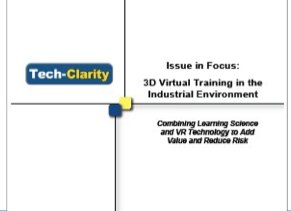 Issue in Focus: 3D Virtual Training in the Industrial Environment: Combining Learning Science and VR Technology to Add Value and Reduce Risk reviews the science behind training using 3D Virtual Reality (VR) and discusses the opportunity for industrial companies to leverage 3D Virtual Training. The research presents how 3D Virtual Training stimulates learning, discusses how gaming technology has made virtual simulators accessible to today’s manufacturers, and shares a number of real world examples of using 3D Virtual Training to overcome training challenges common to industrial settings.
Issue in Focus: 3D Virtual Training in the Industrial Environment: Combining Learning Science and VR Technology to Add Value and Reduce Risk reviews the science behind training using 3D Virtual Reality (VR) and discusses the opportunity for industrial companies to leverage 3D Virtual Training. The research presents how 3D Virtual Training stimulates learning, discusses how gaming technology has made virtual simulators accessible to today’s manufacturers, and shares a number of real world examples of using 3D Virtual Training to overcome training challenges common to industrial settings.
Please enjoy the summary below, or click the report or title to download the full PDF (free of charge, no registration required).
For more information on 3D Virtual Training, please see additional information from Dassault Systems on 3DVIA Studio.
Table of Contents
- Introducing the Issue
- Simulation Offers a Solution for Some
- 3D Virtual Training Accessibility Expanding in Industry
- Know what Virtual Reality Is (and Isn’t)
- Explore the Science of Virtual Reality for Learning
- Leverage (Military and) Gaming Industry Investments
- Utilize 3D Assets to Reduce Effort
- Learn from Others
- Conclusion
- Recommendations
- References
- About the Author
Introducing the Issue
Training employees in industrial environments is important to running a sound business. Effective training reduces risk, decreases liability, and satisfies compliance demands. Perhaps more importantly it improves efficiency, speeds up startup and deployment times, and increases productivity. Few would argue with the value of good training.
Unfortunately, some industrial settings make it challenging and costly to train personnel on real equipment or in the actual environment. Facilities like oilrigs often lie in remote locations where transporting instructors and trainees is expensive. Other settings may be unsuitable for training due to the danger placed on untrained workers. Learning skills such as cleaning up hazardous waste or combatting a fire in a hazardous environment like a nuclear facility can also be extremely difficult. In addition to being extremely dangerous for the novice trainee to explore for the first time, some environments are just not conducive to training. For example, emergency response exercises in a subsurface mine would be hard for instructors to observe and provide feedback because of the dark, cramped environment.
Even if safety isn’t an issue, training in some industrial environments may carry opportunity costs that negatively impact profitability. Taking equipment offline for training purposes leads to lost productivity. Temporarily scheduling a forklift for training might be acceptable, but there would be major cost implications to shutting down capital equipment producing “24/7.” In other cases, it might not be worth risking expensive assets in the hands of trainees, where a single mistake could damage expensive or delicate equipment. In some scenarios, taking equipment out of service for training purposes is simply impractical from a scheduling perspective. For example, training new crewmembers on a vessel that requires a quick turnaround at the dock may not allow adequate time for effective training. There are also situations where the equipment or assets are not yet physically available, making it impossible to train operators until construction is complete.

